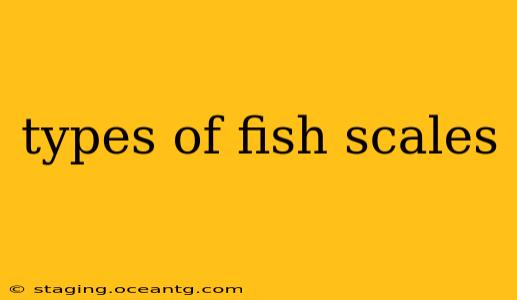Fish scales, those seemingly insignificant structures covering the bodies of most fish, are actually fascinating biological marvels. They provide protection, reduce drag in the water, and even contribute to camouflage. But did you know there are several different types of fish scales? Understanding these variations offers a glimpse into the incredible diversity of the aquatic world. This guide explores the primary types of fish scales, their characteristics, and the fish species that possess them.
What are the different types of fish scales?
Fish scales are broadly classified into four main types: cycloid, ctenoid, ganoid, and placoid. Each type has distinct features that reflect evolutionary adaptations to different environments and lifestyles.
1. Cycloid Scales
These are the most common type of fish scale, characterized by their circular shape and smooth edges. They're thin, flexible, and overlapping, like shingles on a roof. Cycloid scales are found in many bony fishes (Osteichthyes), including:
- Salmonids: Salmon, trout, and char.
- Cyprinids: Carp, goldfish, and minnows.
- Clupeids: Herrings, sardines, and anchovies.
2. Ctenoid Scales
Similar to cycloid scales in their overlapping arrangement, ctenoid scales are distinguished by the presence of tiny, comb-like teeth (ctenii) along their posterior edge. This rough texture likely provides extra protection against predators or parasites. Ctenoid scales are also found in many bony fishes, including:
- Perciforms: Bass, perch, and sunfish.
- Pleuronectiformes: Flounders and halibut.
- Anguilliformes: Eels (some species)
3. Ganoid Scales
Ganoid scales are considerably different from cycloid and ctenoid scales. They are rhomboidal (diamond-shaped), thick, and bony, with a hard, enamel-like surface. These scales are less flexible and do not overlap as extensively as the other types. Fish with ganoid scales are relatively few in number and include:
- Gars: Long, slender freshwater predators.
- Bichirs: Ancient-looking freshwater fish from Africa.
- Sturgeons: Large, valuable fish known for their caviar.
4. Placoid Scales (Dermal Denticles)
These are unique scales found only in cartilaginous fishes (Chondrichthyes), such as sharks, rays, and chimaeras. Instead of being flat and overlapping, placoid scales are small, tooth-like structures embedded in the skin. Each scale has a central spine (denticles) projecting outward, giving the skin a rough, sandpaper-like texture. This structure is remarkably similar to teeth in structure and development.
How do fish scales develop?
Fish scale development is a complex process involving specialized cells in the dermis (the lower layer of the skin). The scales grow incrementally, adding layers as the fish grows, much like tree rings. These growth rings can be used to estimate the age of the fish.
Do all fish have scales?
No, not all fish have scales. Some species, such as catfish, eels, and some types of sharks, have skin covered in mucus or other protective structures instead of scales.
What is the function of fish scales?
Fish scales serve several crucial functions:
- Protection: Scales offer a physical barrier against parasites, pathogens, and minor injuries.
- Camouflage: The color and pattern of scales can help fish blend into their environment.
- Hydration: Scales help prevent excessive water loss.
- Reduce Drag: The shape and overlapping arrangement of scales minimize friction with water, improving swimming efficiency.
What are the differences between cycloid and ctenoid scales?
The primary difference between cycloid and ctenoid scales lies in their edges: cycloid scales have smooth edges, while ctenoid scales possess comb-like projections (ctenii) along their posterior margin. Both are thin, overlapping scales found in bony fishes, but their differing textures reflect adaptations to different environments and lifestyles.
What are the advantages and disadvantages of different scale types?
Each scale type offers advantages and disadvantages. Ganoid scales provide excellent protection but limit flexibility. Placoid scales are incredibly efficient in reducing drag and offer protection, however, the lack of overlap makes them vulnerable in certain situations. Cycloid and ctenoid scales offer a good balance of protection and flexibility. The evolutionary success of each scale type reflects its effectiveness in a particular ecological niche.
This comprehensive overview highlights the diversity and importance of fish scales. Their variations reflect millions of years of evolutionary adaptation, resulting in the wide range of forms and functions observed in the fishes of today.
